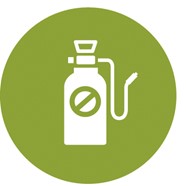A pesticide, or a plant protection product, is any substance or mixture of substances used to destroy, suppress or alter the life cycle of anything that is not wanted on a crop. A pesticide can be a naturally derived or synthetically produced substance and can also be an organism, for example, the bacterium Bacillus thuringiensis which is used to control a number of insect pests.
Pesticides include, fungicides, herbicides, insecticides, lures, rodenticides and repellents. They are used in commercial, domestic, urban and rural environments. There are currently thousands of pesticide products registered. A lot of the products are allowed to use in several different legislations and others are not (any more).
Primoris started as a lab with the specialty of just pesticides and therefore we have a lot of experience with these products.
 Legislation
Legislation
At Primoris, specialists work on this topic. It is made sure that legislation on pesticides is always up to date in our system so your results will always be shown with the right and updated legislation.
 Analysis methods
Analysis methods
Primoris has developed multi-residue methods not with the purpose to obtain the largest scope possible, but to produce relevant analysis methods which are providing the highest possible assurance.
 Sample matrix
Sample matrix
Primoris analyses pesticides on a wide range of products such as fresh vegetables, fruit and potatoes, ...
 Certified by
Certified by
Primoris started as a lab with the specialty of just pesticides and therefore we have a lot of experience with the residue analysis of pesticides in food and feed.

Newsletter highlight
Primoris is part of relana, the quality circle of a dozen European labs concerning analysis of pesticides and contaminants. Earlier this year Primoris saw a relana audit and received excellent feedback. In the first place the lab shows a high and stable level of quality and furthermore, the auditors were impressed with the competence of our staff.
Flash news
Due to the efforts of our in-house R&D team, we can now offer a drastically lower reporting time for the analysis of acrylamide, as well as a lowered reporting limit.
Legislation | Inorganic arsenic in cereal, rice and babyfood
On 06/03/2023 the European Commission published regulation 2023/0465 regarding the maximum levels of inorganic arsenic in certain foods.
As of now we will analyse maleic hydrazide (MH) using LC-MS/MS instead of UV, resulting in faster and more precise results.

